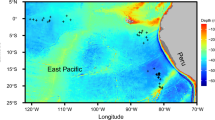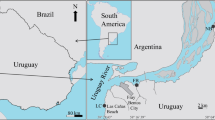Summary
Mean values of energetic parameters are used in ecosystem studies because only crude estimates are possible when dealing with a large scope. However, when the focus is at the population level, finer resolution is possible and thus potential ontogenetic differences should be examined. Analysis of energetic parameters of a population of terrestrial salamander, Plethodon cinereus, was undertaken in order to determine ontogenetic differences.
Digestive efficiency does not differ significantly between age classes, nor is it correlated with energy intake. Adult males and non-gravid females have virtually identical mean efficiencies. Thus it is probably meaningful to calculate energy flow through the population using a mean digestive efficiency value. Percent water content decreases significantly with increasing age whereas percent ash content increases significantly. Thus when estimating energy tied up in standing crop, correction must be applied for ontogenetic differences in water and ash content. Once these corrections have been made, the AFDW-specific energy content is not significantly different between age groups (with the exception of gravid females which is higher). Salamanders accumulate energy in their tissues with increasing age, although immatures are not significantly different from non-gravid adults. Since gravid females have significantly more joules/mg wet weight than other groups, separate energy density values must be calculated for these individuals if a meaningful standing crop energy estimate is to be obtained from wet weight biomass.
Similar content being viewed by others
References
Burton, T.M., Likens, G.E.: Energy flow and nutrient cycling in salamander populations in the Hubbard Brook Experimental Forest, New Hampshire. Ecology 56, 1068–1080 (1975a)
Burton, T.M., Likens, G.E.: Salamander populations and biomass in the Hubbard Brook Experimental Forest, New Hampshire. Copeia 1975(3), 541–546 (1975b)
Heatwole, H.: Environmental factors influencing local distribution and activity of the salamander, Plethodon cinereus. Ecology 43, 460–472 (1962)
Jaeger, R.G.: Potential extinction through competition between two species of terrestrial salamanders. Evolution 24(3), 632–642 (1970)
Jaeger, R.G.: Food as a limited resource in competition between two species of terrestrial salamanders. Ecology 53, 535–546 (1972)
Kitchell, J.F., Windell, J.T.: Energy budget for the lizard, Anolis carolinensis. Physiol. Zool. 45(2), 178–188 (1972)
Merchant, H.: Estimated energy budget of the red-backed salamander, Plethodon cinereus. Ph.D. Dissertation, Rutgers University. University Microfilms, No. 71-3082 (1970)
Paine, R.T.: The measurement and application of the calorie to ecological problems. Ann Rev. Ecol. Syst. 2, 145–164 (1971)
Petrusewicz, K., Macfadyen, A.: Productivity of terrestrial animals, principles and methods. IBP Handb. 13. Philadelphia, Pa.: F.A. Davis Company 1970
Phillipson, J.: A miniature bomb calorimeter for small biological samples. Oikos 15, 130–139 (1964)
Reiners, W.A., Reiners, N.M.: Comparison of oxygen-bomb combustion with standard ignition techniques for determining total ash. Ecology 53, 132–136 (1972)
Ricklefs, R.E.: Energetics of reproduction in birds. In: Avian energetics (R.A. Paynter, Jr., ed.), pp. 152–292. Cambridge, Massachusetts: Nuttall Ornithological Club 1974
Sayler, A.: The reproductive biology of the red-backed salamander, Plethodon cinereus, in Maryland. Copeia 1966(2), 183–193 (1966)
Wassersug, R.J.: The mechanism of ultraplanktonic entrapment in anuran larvae. J. Morph. 137(3), 279–288 (1972)
Wassersug, R.J.: The adaptive significance of the tadpole stage with comments on the maintenance of complex life cycles in anurans. Amer. Zool. 15, 405–417 (1975)
Wiegert, R.G.: Intraspecific variation in calories/g of meadow spittlebugs (Philaenus spumarius L.). BioScience 15(8), 543–545 (1965)
Author information
Authors and Affiliations
Rights and permissions
About this article
Cite this article
Crump, M.L. Intra-population variability in energy parameters of the salamander Plethodon Cinereus . Oecologia 38, 235–247 (1979). https://doi.org/10.1007/BF00345185
Received:
Issue Date:
DOI: https://doi.org/10.1007/BF00345185




